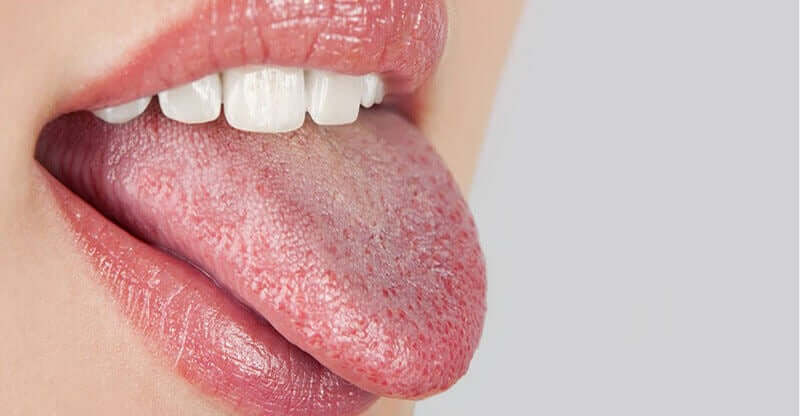Burning Mouth Syndrome: Identification and Treatment

Burning mouth syndrome, also called glossodynia, is a pathology characterized by xerostomia in women over the age of 50.
Saliva is a fundamental element in maintaining oral health, as it’s the natural lubricant of the oral tissues. It’s also fundamental for digestion, as it forms the alimentary bolus. Finally, it prevents the proliferation of conditions such as cavities or periodontal diseases.
What is xerostomia?
Xerostomia is the reduction of salivary flow in a state of rest. It’s more prevalent from the age of fifty onwards, especially in women, due to hormonal changes.
This can be a passing pathology, having to do with, for example, a state of anxiety and infection, among other factors. However, it can also be permanent, having to do with the consumption of alcohol, tobacco, chemotherapy, etc.
Read also: Tooth Decay: What Causes Dental Cavities?
What is burning mouth syndrome?

As we’ve said before, it’s a pathology characterized by xerostomia, especially in women from the age of fifty. Normally, it has to do with hormonal changes, such as the menopause. It’s three times more frequent in women than in men.
Patients with this syndrome also experience dysgeusia, which is the difficulty in swallowing. Hyposalivation is associated with gingivitis, cavities, or halitosis. Saliva usually becomes thicker and denser and the mucosa is dry, irritated, and red. Often, patients present symptoms such as the following:
- Burning in the mouth and on the tongue
- Chapped lips
- Dry mouth
- Presence of ulcers
- Constant thirst
- An increase in the accumulation of dental plaque
Discomfort usually increases during the evening and patients also refer to a metallic or bitter taste. In addition, it’s very common for cavities to appear in the area of the neck of the teeth, in the roots of the teeth. This is due to the decrease in the natural autolysis that the saliva produces.
How can we treat it?
If the cause is peripheral, having to do with drugs or other illnesses, then the syndrome will disappear when these causes disappear. If the syndrome has nothing to do with any other cause, then treatment will focus on an increase in saliva, avoiding the side effects of hyposalivation.
Doctors often give dietary and health advice to induce increased saliva production. Salivary stimulants combined with salivary substitutes are often used to increase salivation. They’re usually available as sprays, toothpastes, and mouthwashes.
What can we do to prevent it?

In order to prevent this pathology or to remedy its symptoms naturally, we can take into account the following recommendations:
- Try to lead a more relaxed life, reducing stress.
- Increase the consumption of liquids in your diet, making sure to drink about two liters of water a day.
- Try different mild toothpastes, without a strong menthol flavor.
- Avoid drinking acidic liquids and foods, carbonated drinks, or coffee.
- Avoid cinnamon.
- Reduce or eliminate alcoholic drinks from your diet, as well as products with alcohol.
- Eliminate spicy foods from your diet.
- Stop smoking or reduce it as much as possible.
Don’t miss: Why Are Sensitive Teeth Prone to Pain?
In short
You should consult a professional whenever you experience changes in the amount of salivation, irritations in the mucous membrane, or any other symptom that’s prolonged over time are felt.
This isn’t only to treat it, but also to rule out other possible pathologies such as diabetes mellitus or some type of tumor. Your doctor or dentist will be able to identify the different possible origins of the pathology in order to start dealing with it.
All cited sources were thoroughly reviewed by our team to ensure their quality, reliability, currency, and validity. The bibliography of this article was considered reliable and of academic or scientific accuracy.
- Bookout GP, Short RE. Burning Mouth Syndrome. [Updated 2019 Mar 9]. In: StatPearls [Internet]. Treasure Island (FL): StatPearls Publishing; 2019 Jan-. Available from: https://www.ncbi.nlm.nih.gov/books/NBK519529/
- Aravindhan R, Vidyalakshmi S, Kumar MS, Satheesh C, Balasubramanium AM, Prasad VS. Burning mouth syndrome: A review on its diagnostic and therapeutic approach. J Pharm Bioallied Sci. 2014;6(Suppl 1):S21–S25. doi:10.4103/0975-7406.137255
- Feller L, Fourie J, Bouckaert M, Khammissa RAG, Ballyram R, Lemmer J. Burning Mouth Syndrome: Aetiopathogenesis and Principles of Management. Pain Res Manag. 2017;2017:1926269. doi:10.1155/2017/1926269
- Nasri-Heir C, Zagury JG, Thomas D, Ananthan S. Burning mouth syndrome: Current concepts. J Indian Prosthodont Soc. 2015;15(4):300–307. doi:10.4103/0972-4052.171823
This text is provided for informational purposes only and does not replace consultation with a professional. If in doubt, consult your specialist.








